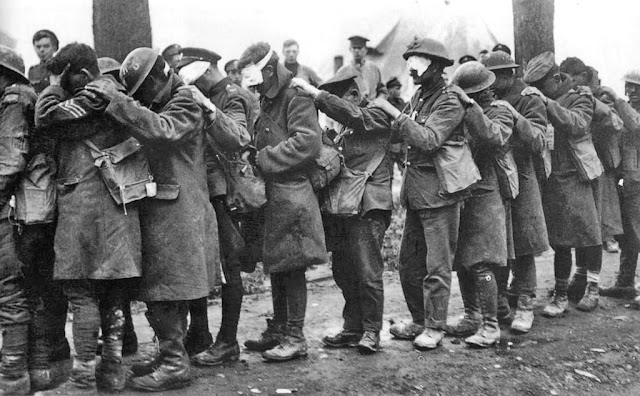---------oOo---------
Blind leading the blind
Meaning:
A person ignorant of a given subject is getting advice and help from another person who is just as ignorant of the subject
Bible origin:
Matthew 15:13-14, Christ referring to the Pahrisees:
"Every plant that my heavenly Father has not planted will be pulled up by the roots. Leave them; they are blind guides. If the blind lead the blind, both will fall into a pit."
Comments:
The phrase and concept appear in earlier texts and works:
Sanskrit texts giving rise to Hinduism:
Abiding in the midst of ignorance, thinking themselves wise and learned, fools go aimlessly hither and thither, like blind led by the blind.
— Katha Upanishad, c 800BC
North India Hindu:
Suppose there were a row of blind men, each holding on to the one in front of him: the first one doesn't see, the middle one doesn't see, the last one doesn't see. In the same way, the statement of the Brahmans turns out to be a row of blind men, as it were: the first one doesn't see, the middle one doesn't see, the last one doesn't see.
— Canki Sutta, oral tradition committed to writing c 29BC
Roman recording:
"Nor does the non-expert teach the non-expert—any more than the blind can lead the blind."
Sextus Empiricus (160 – 210BC) comparing ignorant teachers and blind guides in Outlines of Scepticism:
The most famous artistic depiction of the phrase is Pieter Bruegel's The Blind Leading the Blind, completed in 1568 and currently in the collection of the Museo di Capodimonte in Naples, Italy:
It portrays a line of five blind men, in progressive stages of losing their balance, following the fate of their blind leader, who has already fallen into a stream. We see him, dramatically foreshortened, wallowing on his back, still holding his hurdy-gurdy, the musical instrument commonly associated with beggars. The men have evidently been making their way along a path leading from a village. They are linked together by wooden staves and are guided by placing their hands on the shoulders of the next man in front.
Cornelius Massys’ engraving The Blind Leading the Blind is from the 1550s, however, Bruegel’s work is the earliest known painting of the subject.
Detail
John Singer Sargent’s poignant 1919 painting Gassed has a modern echo of the above in depicting a line of soldiers blinded by a gas attack heading towards a dressing station. Sargent was commissioned by the British War Memorials
Committee to document the war and visited the Western Front in July 1918
spending time with the Guards Division near Arras, and then with the American
Expeditionary Forces near Ypres. The painting was finished in March 1919 and
voted picture of the year by the Royal Academy of Arts in 1919. It is now held
by the Imperial War Museum.
A photograph similar to Gassed of British troops blinded by poison gas during the Battle of Estaires, 1918
---------oOo---------
Cast pearls before swine
Meaning:
To offer something prized, helpful or valuable to someone who does not appreciate it.
Bible origin:
Matthew 7:6:
"Do not give what is holy to the dogs; nor cast your pearls before swine, lest they trample them under their feet, and turn and tear you in pieces."
The biblical text is generally interpreted to be a warning by Jesus to his followers that they should not offer biblical doctrine to those who were unable to value and appreciate it.
Comments:
At the time both dogs and pigs were poorly regarded. Dogs were part of society, but were half wild and roamed the region in packs that were sometimes dangerous to humans. The word used here refers specifically to dogs without a human master. They were unclean and would eat whatever scraps and carrion they came across. Pigs were the quintessential unclean animal and were closely associated with the Gentile communities in the region which kept them in large numbers. Pearls were a luxury of extreme value.
The metaphor seems to be teaching against giving what is considered just or holy to those who do not appreciate it. Animals such as dogs and pigs cannot appreciate ethics, and this verse implies that there is even some class of human beings who cannot, either.
Historically, a common view was that this verse refers to the Eucharist, that only baptized individuals ought to receive the Eucharist.
One modern argument is that dogs and pigs represent Gentiles and heathens, and that this verse is demonstrating that Jesus' original message was intended only for the Jews. In Jewish literature heathens were often compared to dogs, and the unclean pig was a Jewish symbol for the Roman Empire.
The alternative interpretation is that dogs and pigs are not metaphors for some group of people, but for the unholy in general. This verse is not about excluding some group from God's teaching, but rather ensuring that those things that are God's are kept holy. Thus the Temple is kept clean, religious meals treated with respect, and holy days honoured and kept separate from the turbulence and impiety of daily life.






No comments:
Post a Comment
Note: Only a member of this blog may post a comment.